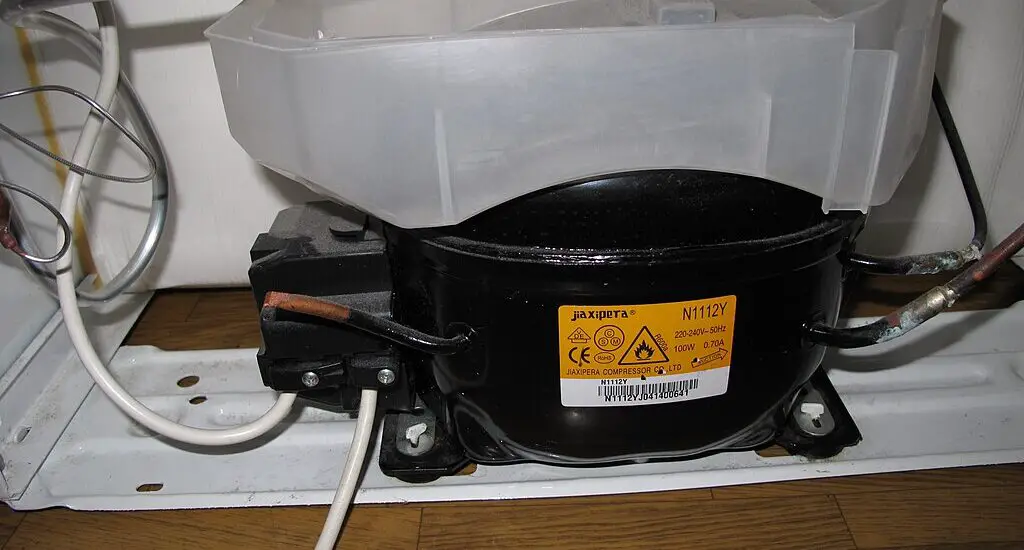If the question, “Can I replace a refrigerator compressor myself?” has brought you here, rest assured we have the information you need. Let’s explore this question comprehensively, examining the pros, cons, and risks involved.

Table of Contents
Answering the Central Question: Can I Replace a Refrigerator Compressor Myself?
Yes, from a technical standpoint, you could replace a refrigerator compressor yourself. However, this task isn’t for the faint-hearted. It involves electrical work, mechanical adjustments, and the handling of potentially hazardous materials like refrigerants. Plus, doing it incorrectly could void any existing warranties on your appliance.
Because of these complexities and risks, the general recommendation leans towards hiring a certified technician to handle the job. Some manufacturer warranties might even make this a requirement. Hiring a professional ensures safety and might save you from legal complications related to refrigerant disposal.
Pros and Cons of Replacing the Compressor Yourself
Before you make the choice to tackle this task, it’s vital to weigh the pros and cons carefully.
Pros
Below are the pros of replacing the compressor yourself:
Cost Savings: Hiring a professional can cost between $200 to $400 just for labor, not including parts. If you do it yourself, you can significantly reduce this expense. However, remember you’ll still need to purchase the compressor and potentially some specialty tools.
Skill Development: Managing to replace a compressor yourself provides you with valuable hands-on experience. These technical skills might prove useful for future DIY projects, possibly making you more self-reliant when it comes to appliance repair.
Cons
Below are the cons of replacing the compressor yourself:
Risks: Electrical components in a refrigerator work with high voltage. Incorrectly connecting or disconnecting these can result in a severe electrical shock. There’s also the risk of incorrectly handling refrigerants, which are harmful substances.
Efficiency: A wrongly installed compressor can lead to inefficiencies, like poor cooling and increased electricity consumption. In the worst-case scenario, you may ruin your refrigerator, requiring the purchase of a new one.
Legal Concerns: Mishandling refrigerants violates environmental laws. Certified technicians have the necessary training and equipment to handle refrigerants safely and legally. Incorrect disposal or release into the atmosphere could result in significant legal repercussions, including fines.
Risks Involved
Since replacing a refrigerator compressor involves high-stakes operations, you must understand the risks you’re taking.
Electrical Shocks: Compressors use high voltage, typically ranging from 120V to 240V, depending on the appliance. Mishandling the electrical connections can result in severe shocks, which could be fatal.
Refrigerant Handling: Refrigerants, such as R-134a or R-600a, are chemicals that can be harmful when inhaled or when they come into contact with skin. Moreover, incorrect disposal of these substances can have detrimental effects on the ozone layer and is against the law.
Property Damage: While the compressor is only one part of the refrigerator, its interconnectedness with other components means that a mistake can result in broader system failures. You might end up damaging other components, like the condenser or evaporator, which will increase the overall repair costs or could render your refrigerator unusable.
Check out these other articles…
Are Refrigerator Compressors Recyclable? Detailed Answer
Are Fridge Compressors Dangerous? The Facts You Need to Know
Is It Worth Replacing Compressor on Refrigerator? Answered
Can a Refrigerator Compressor Explode? What Experts Say
Can a Refrigerator Compressor Catch Fire? Detailed Answer
Steps to Replace a Refrigerator Compressor
If you still choose to go ahead, below is a detailed step-by-step guide to replacing a refrigerator compressor.
Diagnose the Issue: Use a multimeter to test the compressor’s electrical resistance. If the readings are off, it’s likely the compressor needs replacement.
In need of a multimeter? Get this from Walmart now!
Unplug the Refrigerator: Before touching anything, unplug the refrigerator to ensure there’s no active electrical current.
Remove the Back Panel: The compressor is usually located at the back. Unscrew the back panel to gain access to it.
Discharge the Refrigerant: Due to legal and environmental concerns, a certified technician should do this. They will use a refrigerant recovery machine to safely remove the refrigerant.
Remove the Old Compressor: There will be electrical wires attached to the compressor and copper tubes for the refrigerant. Carefully disconnect these, then unscrew the compressor from its mounting brackets.
Install the New Compressor: Place the new compressor where the old one was and carefully re-attach the electrical wires and copper tubes. Make sure all connections are secure.
Charge with Refrigerant: Again, due to the sensitive nature of handling refrigerants, a certified technician should do this part.
Test: After everything is connected and the back panel is reattached, plug the refrigerator back in. Monitor it for a few hours to ensure it’s cooling as expected.